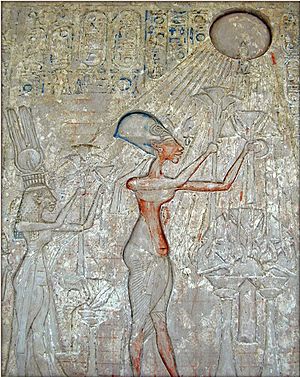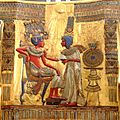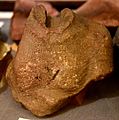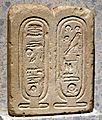
Pharaoh
Akhenaten and his family worshiping the Aten
Aten was the disk of the Sun in ancient Egyptian mythology. It was also seen as a god. People in ancient Egypt pictured Aten as the sun itself. Its rays often ended in tiny hands. These hands sometimes held the ankh, which was a symbol for life. Aten was a part of the powerful sun-god Ra.
Atenism: Worshiping One God
Aten became the main focus of a special religion called Atenism. This religion was started by a pharaoh named Amenhotep IV. He later changed his name to Akhenaten. He did this to show his strong belief in Aten. Akhenaten wanted people to worship only Aten. This was a very new idea for ancient Egypt. Most Egyptians worshiped many different gods. Akhenaten was the first person to try and create a religion that focused on just one god.
Akhenaten's Great Hymn
Akhenaten wrote a famous poem called the Great Hymn to the Aten. In this poem, he praised Aten as the creator of everything. He said Aten was the one who gave life to all living things. This hymn shows how deeply Akhenaten believed in Aten's power.
The End of Aten's Worship
After Akhenaten died, the worship of Aten did not last long. Another pharaoh named Horemheb made sure that the old gods were worshiped again. He ended the religion of Atenism. Many temples and images of Aten were destroyed.
Images for kids
-
The "Great Hymn to the Aten" written from Akhenaten's point of view; the authorship of the hymn is disputed.
-
Relief fragment showing a royal head, probably Akhenaten, and early Aten cartouches. Aten extends Ankh (sign of life) to the figure. Reign of Akhenaten. From Amarna, Egypt. The Petrie Museum of Egyptian Archaeology, London
-
-
Stela of the Great temple of the Aten showing the early form of the Aten's names.
-
-
Limestone fragment column showing reeds and an early Aten cartouche. Reign of Akhenaten. From Amarna, Egypt. The Petrie Museum of Egyptian Archaeology, London
-
Headless bust of Akhenaten or Nefertiti. Part of a composite red quartzite statue. Intentional damage. Four pairs of early Aten cartouches. Reign of Akhenaten. From Amarna, Egypt. The Petrie Museum of Egyptian Archaeology, London
-
Inscribed limestone fragment showing early Aten cartouches, "the Living Ra Horakhty". Reign of Akhenaten. From Amarna, Egypt. The Petrie Museum of Egyptian Archaeology, London
-
Fragment of a stela, showing parts of three late cartouches of Aten. There is a rare intermediate form of the god's name. Reign of Akhenaten. From Amarna, Egypt. The Petrie Museum of Egyptian Archaeology, London
-
Siliceous limestone fragment of a statue. There are late Aten cartouches on the draped right shoulder. Reign of Akhenaten. From Amarna, Egypt. The Petrie Museum of Egyptian Archaeology, London
-
Wall relief. Early cartouches of the god Aten, from Amarna, Egypt. New Kingdom, 18th Dynasty. Neues Museum
-
Bronze plate with a cartouche of Akhenaten and 2 late cartouches of the god Aten. From Amarna, Egypt. 18th Dynasty. Neues Museum
See also
 In Spanish: Atón para niños
In Spanish: Atón para niños

 In Spanish: Atón para niños
In Spanish: Atón para niños













